The 15 Best Restaurant Logos for Inspiration
Logos are an essential part of a restaurant's brand. A good logo should be memorable, convey the restaurant's essence, and help diners recognise the establishment. As they say, we eat with our eyes first, so a striking and delicious logo can draw customers in.
Choosing a suitable logo is crucial in the competitive restaurant industry. The logo appears on signage, menus, uniforms, packaging, and ads. It creates an identity and shapes the customer's perception of the restaurant.
This article looks at 15 of the best restaurant logos that are effective, recognisable, and influence our dining decisions. We analyse why they work and the stories behind their design.
Table of Contents
#1 McDonald's Golden Arches
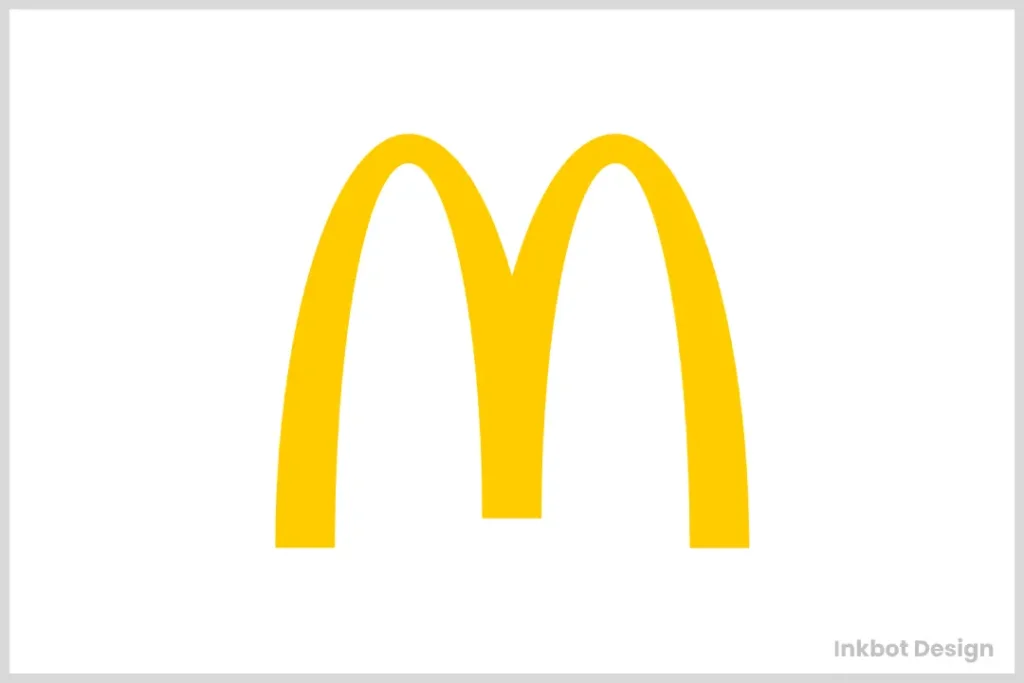
More than just a fast food chain, McDonald's has embedded itself into the very fabric of Americana. The Golden Arches logo serves as a globally renown pop culture icon.
Staking an Archway to Billions
The McDonald's logo features the company's name spelt out in chunky, bold red lettering sandwiched between two bright yellow arch halves reaching up towards each other without quite connecting. This incomplete bridge creates blank space, making the Golden Arches instantly recognisable, even in silhouette.
The arches symbolise welcoming accessibility, the journey bridging hunger to the satisfaction that McDonald's delivers billions served. They create an intuitive pathway leading customers inside for hot meals wrapped in childhood sentimentality.
Key Aspects:
- Iconic Golden Arches
- Red McDonalds lettering
- Solid but simple design
Decades since its first restaurant opened in 1940, McDonald's trademarked logo remains a shining symbol of the American fast food dream.
I'm Lovin' Too Many Calories
McDonald's leaned hard into brand marketing from its early days with roadside signage and wrappers bearing the memorable Golden Arches. Pop culture trends continually remixed it into art and tributes spanning generations.
Unfortunately, public reception hasn't seen the McDonald's logo as so beloved lately. With societal concerns around the health consequences of fast food diets, the iconic arches sometimes serve as a lightning rod for controversy regarding the brand's offerings.
Still, haters can’t argue the brilliant effectiveness of McDonald’s logo design in cementing broad recognition that won’t fade anytime soon. From Moscow to Malibu, those arches scream, “Billions and billions served!”
#2 Starbucks

Starbucks coffeehouse chain has one of the most ubiquitous brand logos on the planet, recognisable at a glance in nearly every corner of the world. Its green and white logo is a global emblem of the coffee-drinking experience.
Siren Song
The Starbucks logo features a two-tailed mermaid encircled by the company's name. Known as the Siren, she appears with her long, flowing hair covering bare breasts. One tail arches seductively behind her while the other wraps around her body below her waist.
It's an unusual image for a mainstream coffee company, harkening back to early seafaring tales when sirens were mythological creatures said to seduce weary sailors with songs promising mystical knowledge.
She became a fitting mascot for Starbucks, capturing the irresistible, exotic allure of coffee's rich aromas and flavours. Customers seem helpless but to follow the siren's call through the store's doors.
Key Details:
- Two-tailed siren mascot
- Flowing hair covers bare chest
- Green and white colour scheme
- Circular design
The logo blends mystique and sensuality around the essential Starbucks experience – an inviting sense of comfort, community, and magic behind every cup of java.
Green With Envy
Besides the captivating siren, Starbucks's logo stands out through its iconic green hue. The rich green dominates the branding, applied to every detail from storefront signage to cups, packaging, uniforms, and more.
The green represents the lush, verdant coffee farms across exotic lands that source Starbucks’ beans. It speaks to health, renewal, freshness, calm, and tranquillity.
Altogether, the quintessential image of the green siren has catapulted Starbucks as the premier global coffee brand atop a caffeinated empire of over 38,000 stores worldwide.
#3 In-N-Out Burger
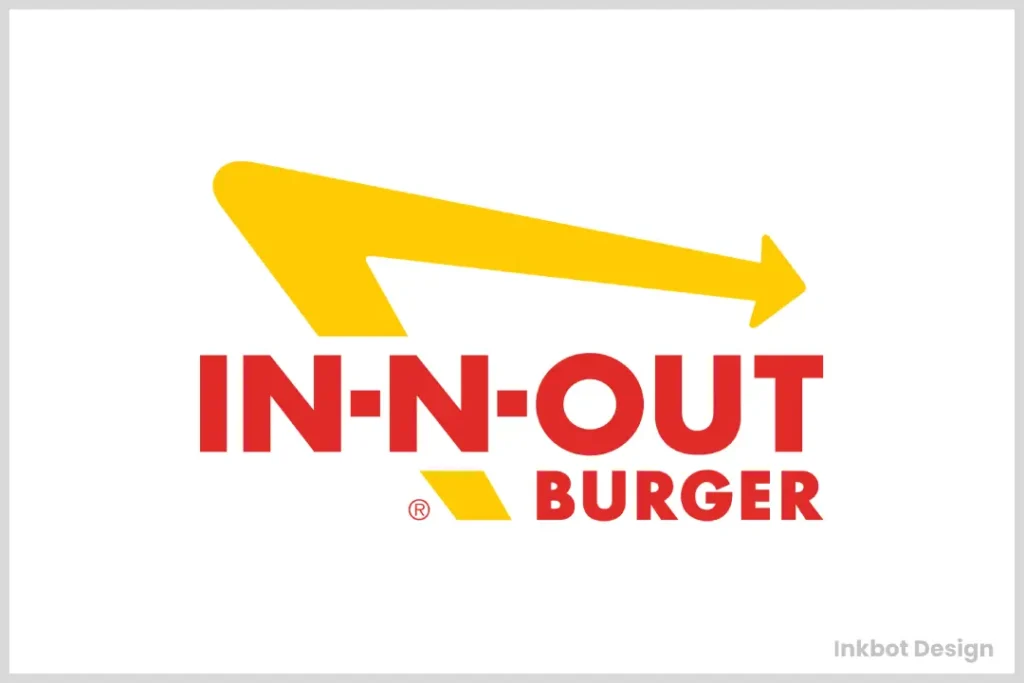
In-N-Out Burger likely has one of the most iconic and recognisable logos in the restaurant industry. Its simple, clean design features vibrant red and yellow colours that pop against most backgrounds.
A Classic Design
The classic In-N-Out logo features the company name in large, bold red letters stacked on top of each other at a slight angle. Underneath is the phrase “Quality You Can Taste” in smaller black all-caps letters.
At the bottom right is In-N-Out's famous arrow graphic pointing diagonally in bright yellow and red from the bottom left to the top right. This design creates a sense of motion and energy fitting for a fast food chain.
Key Features:
- Bright red and yellow colours
- Bold, stacked letters
- Diagonal arrow graphic
- Clean, no-fuss look
The logo brilliantly encapsulates In-N-Out's simple, fresh, and dynamic brand identity. Its vibrant colours and arrow make it instantly recognisable, even from a distance.
Standing the Test of Time
In-N-Out first opened its doors in 1948 in Baldwin Park, California. The restaurant's original logo has almost remained unchanged for over 70 years.
It's a testament to the logo's inherent memorability and visual effectiveness. While many companies have updated their branding over the decades, In-N-Out has remained iconic for generations.
The only updates have been minor tweaks to smooth out rough edges over the years as printing production improved. Otherwise, the current logo stays faithful to its 1948 design roots – proof of a brilliant, age-defying graphic that connects with customers decade after decade.
#4 Domino’s Pizza
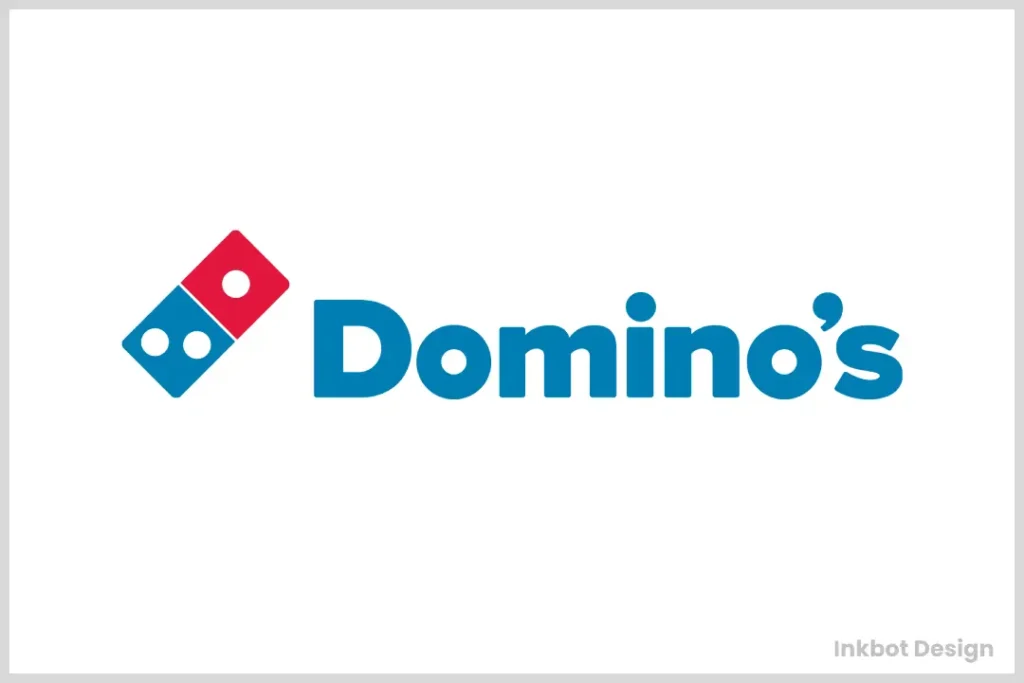
Domino's is one of the largest pizza chains worldwide and delivers its hot, cheesy pies to more than 90 international markets. Its blue-and-red logo pops as an emblem of piping-hot convenience.
Toppings on a Timetable
The Domino’s logo aligns three critical components in a row – the company name, a rectangular image, and the tagline.
The company name appears in slanted blue letters, using a handwriting-style font that evokes personality and puts individual care into order. Below sits a red rectangle sectioned into three vertical boxes with two square dots inside the last cell. This symbolises a domino gaming piece, or the final dot on the pizza box waiting to be tipped over with the next hot delivery.
Underneath, the tagline “Delivering a Million Smiles a Day” adds a friendly, welcoming touch.
Noteworthy Features:
- Blue handwritten logo name
- Red domino image
- Punchy tagline
- Bold colors
With the promise of prompt service backing a tasty pie, hungry customers find every reason to smile with this logo soon pulled up outside.
Leaning Into the Digital Age
In recent years, Domino's upgraded branding to match its industry-leading commitment to digital ordering and delivery innovation.
With most sales flowing from online channels, Domino's introduced a “delivery-only” location concept reflected through new storefront logos, eliminating dine-in references. Sleek, modern designs showcase the tech putting piping-hot pizzas on doorsteps.
It's an intelligent evolution, keeping its logo a relevant symbol of mealtime eased into the digital age.
#5 Little Caesars

As the first national chain offering extra-large pizzas at extra-low prices, Little Caesars Disruptor's roots shine through a fun, affordable logo.
Caesar the Pizza Mascot
The Little Caesars logo features a cute cartoon Roman soldier wearing a feather-crested helmet inspired by Julius Caesar’s military garb. One hand holds a round shield decorated with a soccer ball design. The other hand carries an Italian spear piercing a large oval pizza.
Underneath, the company name appears in large italics, evoking brushed strokes of pizza sauce. “Pizza Pizza” tags two footprint logos for a double emphasis.
Altogether, a spunky Little Caesar mascot warms up affordable quality through familiar Italian themes.
Notable Touches:
- Roman soldier mascot
- Italicised logo font
- “Pizza Pizza” tagline
- Round shapes and warm colours
This logo beams the promise of battle-ready toys and two hot pies for one steal deal.
Pizza Priced for the People
Since Little Caesars opened in 1959, its logo highlighted low-budget quality years before competitors caught on. While others chased premium gourmet angles, Little Caesars athletically stuck to economic fundamentals in price and branding.
The logo straddles accessibility between kids’ cartoonishness and Italian food seriousness – an innocuous balance putting it in pole position as America’s first national value pizza chain.
With hot and ready taglines keeping convenience on tap, Little Caesars continues outpacing steep market competition through affordable logo simplicity.
#6 Pizza Hut

Pizza Hut ranks as the world’s largest pizza restaurant company by location count, its trademark red roof logo delivering hot circles globally across over 18,000 stores.
Quintessential Features
The Pizza Hut logo sits inside a sharp-edged red roof, evoking archetypal Mediterranean architecture where early pizzas first fired up. Underneath the roof appears the company name in solid black lettering using a custom font with rounded edges matching the pizza form.
Beside it rests an iconic design – a red circle with a jaunty wedge slice taken out at 10 o’clock. It resembles a pepperoni pizza slice playfully plated askew and ready to munch.
Core Logo Aspects:
- Red roof image
- Black logo lettering
- Crooked “pizza slice” circle graphic
This cheerful logo ties together Pizza Hut’s heritage of hand-tossed authenticity served up hot under cosy red roofs worldwide.
Building a Household Name
Pizza Hut first launched in 1958 in Wichita, Kansas. Its distinct building architecture included signature red shingled roofs, making locations quickly stand out across townscapes.
Early marketing smartly seized the visual identity linking red rooftops to hot meals waiting inside. Pizza Hut's lean-to design templates are standardised through successive franchise locations, cementing signature red roofs into worldwide familiarity.
Although modern restaurant trends have shifted towards sleeker builds, Pizza Hut’s classic logo still reflects the nostalgia of its roots as America’s first nationwide pizza parlour chain.
#7 Papa John’s
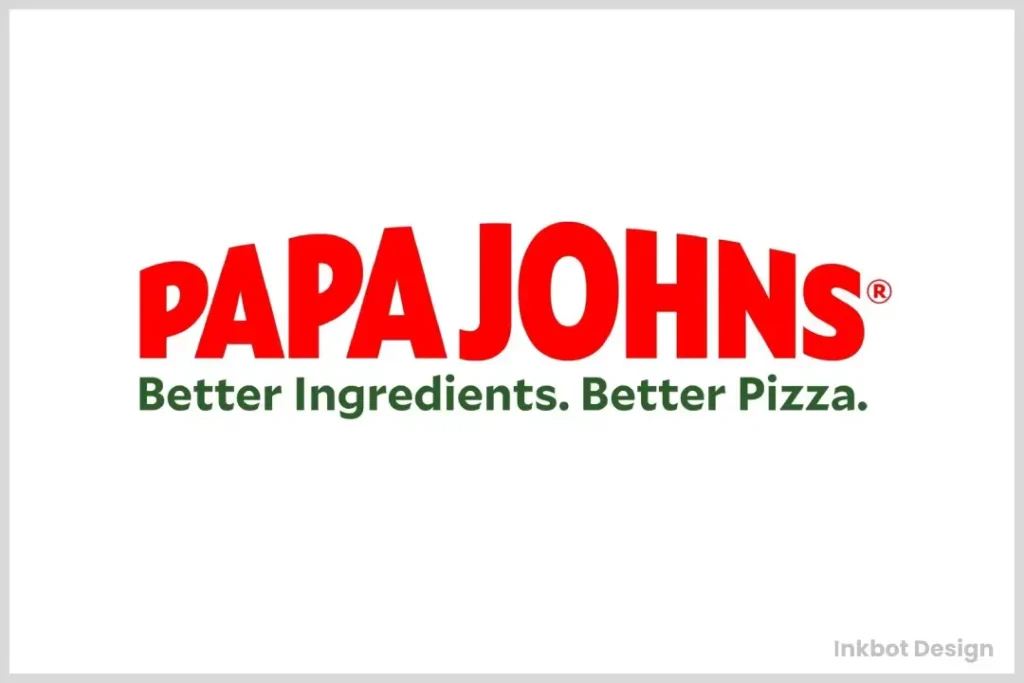
As the world's third-largest pizza delivery chain, Papa John's slings a lot of fresh dough behind a confident logo, putting quality upfront.
Setting Apart Premium Promises
The Papa John’s logo is prominently in the middle, stretching between “Papa” on the left and “John’s” on the right. This visually segments the brand name, emphasising founder John Schnatter as his unique namesake recipe.
Underneath, “Better Ingredients. Better Pizza” makes a bold claim validated through three decades atop restaurant reviews and customer satisfaction awards—unique toppings and fresh dough back up the bravado.
Defining Qualities:
- Centred on “John’s”
- Boastful tagline
- Clean design
- The red and green colour palette
As more pizza competition flooded markets through the 1990s and 2000s, Papa John’s logo graphics refreshed towards bolder messaging that better ingredients beat out steep discounts. Standing confidently apart paid off through rapid growth, earning its current standing.
Keeping Eyes on the Fresh Prize
Unlike pizza peers' marketing deals, Papa John’s built success by prioritising ingredient quality. Its logo continually centres on kitchen credentials – tomato sauce, original dough recipes, natural meats and veggies.
While additional taglines adopted “People Are Priority Always” sentiments after turbulent executive issues, Papa John’s returned focus to food first. Recent design updates simplify around core visual strengths – founder’s name, confidence red, fresh green palette – trusting its original better-ingredients recipe to keep filling loyalty cravings.
#8 KFC
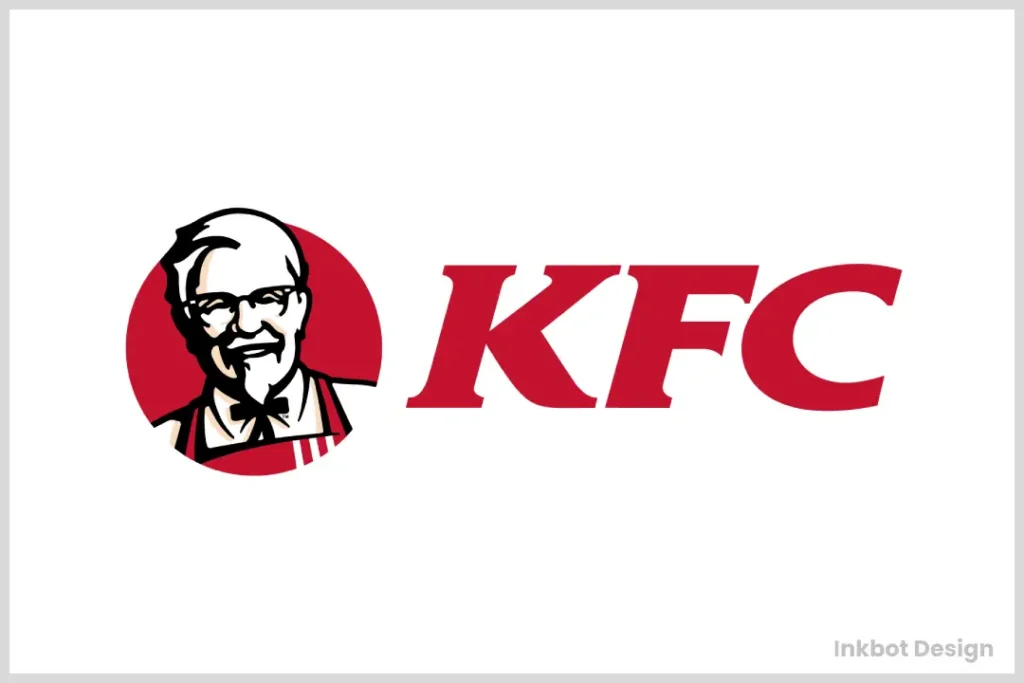
As the second-largest fast-food chicken chain worldwide, KFC fries up global success behind an iconic brand logo nearly as famous as the Colonel himself.
Channelling a Founding Father
The KFC logo features a style sketch of Colonel Harland Sanders wearing his trademark white suit and black western bow tie. His familiar face smiles warmly through crisp outline strokes – white hair, black goatee, and rimless glasses.
To his left, the company name abbreviates Kentucky Fried Chicken to its initials in bold red letters stacked vertically. A bright blue semi-circle swoops around and underneath, adding vivid pop.
Key Brand Imagery:
- The Colonel’s illustrated face
- White suit and black bow tie
- Stacked red KFC lettering
- Vibrant red and blue
Altogether, KFC’s logo brings the Colonel spirit straight off collectable buckets to the core visual identity where he greets hungry customers craving the unique recipe.
Finger Lickin’ to the Bank
KFC proudly is a concept pioneer that launched quick-service fried chicken in 1930 across the American Midwest. Early franchise marketing was smartly centred on Colonel Sander’s charm and food perfectionism to onboard customer trust.
Although the Colonel passed in 1980, KFC globally aligned its logo as a salient tribute to his legacy. The illustrated caricature links enduring positive sentiment and traceability to 11 herbs and spices simmering behind those three snappy red letters.
#9 Wingstop

Specialising in chicken, fries and wings, Wingstop fries up finger-licking success from more than 1,500 locations globally. Its flaming logo fires up cravings hot and fast.
Flying on Wing Power
It’s a visually dynamic design fusing the company name and food focus into the core icon – wings on the move, ready to munch. Accenting green and white colours adds a unique twist for an extra crave factor.
Principal Logo Attributes:
- Central chicken wing image
- Bold green and white colours
- Punchy name integration
The visual identity fast-tracks appetite cues, proclaiming Wingstop the ultimate one-stop wing mecca for finger-licking satisfaction.
Fanning Global Growth
Founded 1994 in Garland, Texas, Wingstop incrementally expanded across domestic regions through the 2000s before accelerating domestic and international growth over the last decade.
Given the near-universal recognition of fried chicken, the logo’s winged design likely contributed to flexible adaption into diverse cultural contexts. Clean visuals also ease replication consistency across different languages and architectural formats.
As cravings for American wing bars gain global traction, Wingstop seems positioned to capitalise on a crispy logo customers already want to try based on sight.
#10 Shake Shack
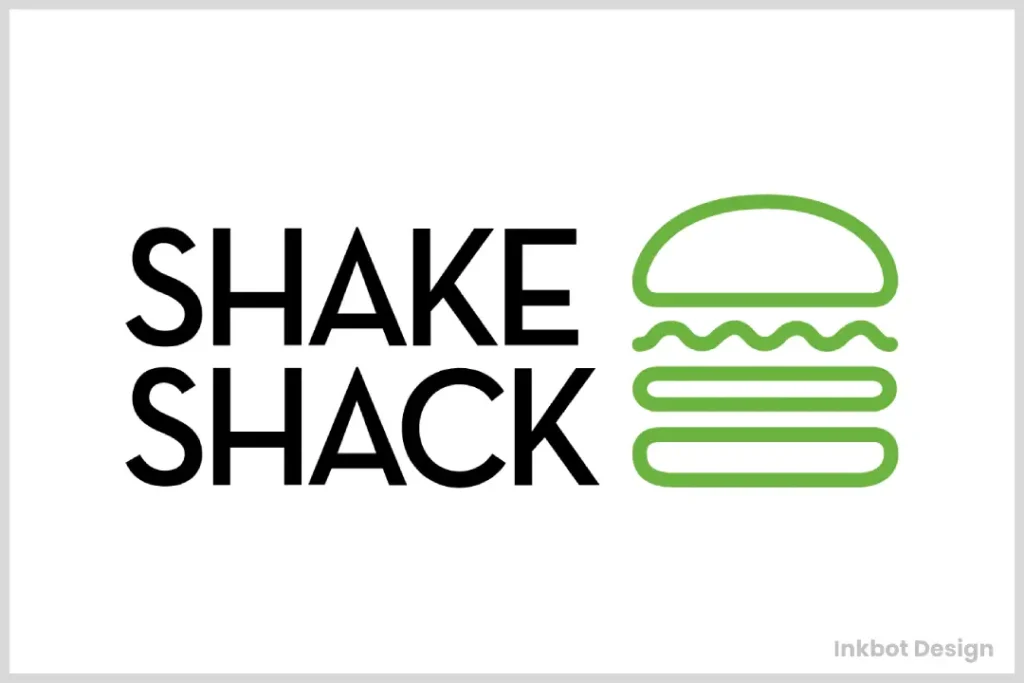
Born from a hot dog cart in Madison Square Park, Shake Shack expanded its premium burgers and shakes to over 300 locations globally. Its playful logo design dishes the basics with a fresh spin.
Roadside Roots Reimagined
The Shake Shack logo features the company's name in rounded white letters grounded by the urban black backdrop. Above left, a flat green rectangle peeks in from the side – an abstract roadside shack shape simplified with asymmetric edge touches echoing original hot cart origins.
Beside the name, a red shack shape interlocks the “k” letter, which splits to reveal a white milkshake cup as the crossbar. It’s a brilliant integration fusing brand names and legacy motifs.
Notable Logo Features:
- A clean mix of colours and shapes
- Integrated shack and shake cup images
- Rounded letters and edges
The friendly logo displays creativity and quality customers can expect in updated takes on roadside classics.
Critically Acclaimed Eats
Despite immense growth since 2004, Shake Shack keeps a chef-driven mentality in every location's kitchen. Seasonal offerings, premium ingredients, and chilli hot takes on frozen custards link back to its fine dining roots.
This innovative outset carries through the logo’s blend of humble charm updated to loftier finishes. Sans serif lettering adds contemporary polish. A flat, asymmetric shack shape incorporates offbeat lines echoing original hot dog cart services.
It’s a stroke of genius – familiar flavours reinvented just enough while retaining the old-fashioned, come-as-you-are community spirit that draws back happy regulars of all walks.
#11 Subway
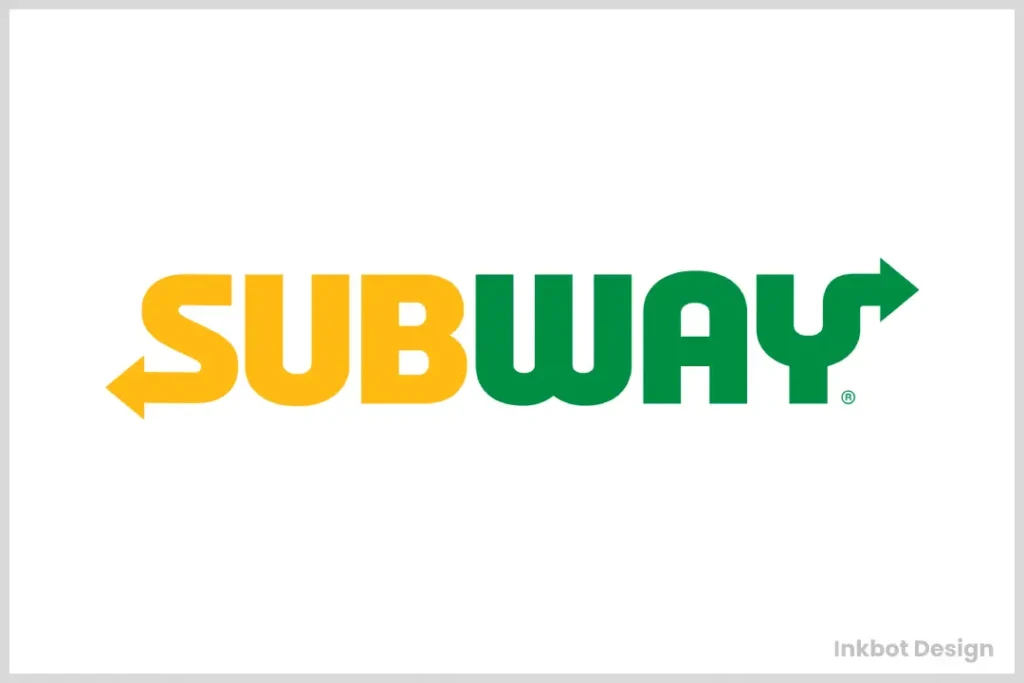
With over 40,000 stores spanning 100+ countries, SUBWAY® sets the world record for most restaurant locations belonging to a single brand. Its vibrant green and yellow logo universally flags made-to-order sandwiches nearby.
Sandwiches on a Streak
The Subway logo speeds with stacked lines trailing behind a bold arrow angled diagonally to the upper right. Both arrows and stripes are rendered in Subway’s signature yellow and green colours, which match their food prep gear.
Underneath, “SUBWAY” headlines cleanly in significant capital white letters on a solid green background. Beside it, a registered trademark “®” symbol protects their iconic winged arrow icon.
Core Identifiers:
- The colour scheme of green and yellow
- Diagonal arrow with trailing lines evoking movement
- Crisp, visually aligned text
This energetic logo spells out Subway’s commitment to quick customisation on signature baked bread dashed with sauces or spices to satisfy.
Charting a Healthy Change
Subway opened in 1965 Connecticut as “Pete’s Super Submarines” before rebranding and expanding nationally through 1974. Early logos simply stamped the name on white bricks, mimicking sandwich fillings.
Modern generations overhauled visuals to showcase fresh, healthy offerings catering to contemporary wellness trends. Bright green evokes veggie crispness and renewal. Energetic lines echo balanced lifestyles powered by personalised tastes.
It’s a brilliant shift aligning Subway’s core strengths with relevant lifestyle priorities. Customers continue biting at billions of sandwiches globally, counting on the familiar green and yellow to deliver fresh fixes fast.
#12 Dairy Queen
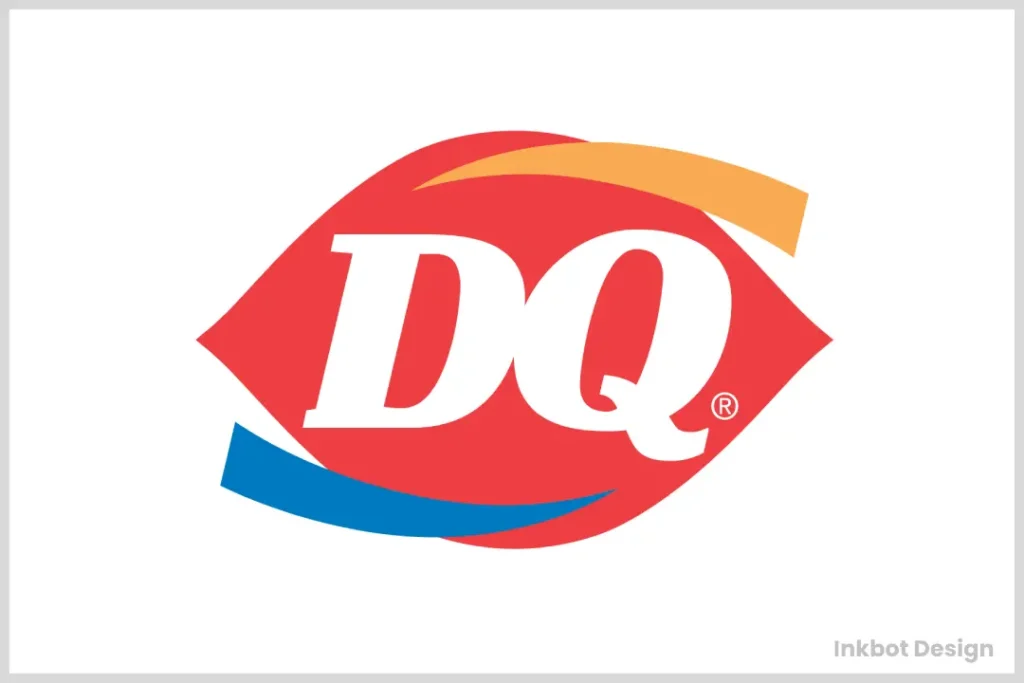
With over 7,000 soft serve shops spanning over two dozen countries, Dairy Queen sweetens up restaurant logo fame through iconic ice cream treat shapes.
A Royal Treat
True to the name, the Dairy Queen logo centres around a regal ice cream cone mascot wearing a tiara and wrapping its hands gingerly around a tall, swirly soft serve cone. The cone and ice cream feature bold red graphics calling extra attention. Underneath, “Dairy Queen” headlines are in solid blue and red letters, using a playful cursive font to add personality.
A small circled “R” trademark icon accompanied by a detailed backstory – “Since 1940” – links heritage rounding quality taste proven over generations.
Principal Logo Aspects:
- Central Royal Ice Cream cone mascot
- Bold red and blue colours
- Custom cursive font spelling out “Dairy Queen”
- The classic emblem of the soft serve treat
This cheerful logo brings lovely vibes of enjoying feel-good frosty treats with friends on a hot day. The crowned cone queen promises deliciousness worth its royal stripes.
An Empire Built on Soft Serve
The inaugural Dairy Queen opened in 1940 in Joliet, Illinois and was established by John Fremont “Grandpa” McCullough and his son Alex. Their signature product, “soft serve” ice cream made with milk and air blasted through a Taylor spindle freezer, created a lighter, fluffier frozen dessert with instant widespread appeal.
From the early days, branding seized on soft serve as a hero feature. Logos spotlighted the twirly cone, and trademark scripts touted “World's Largest Retailer of Soft Ice Cream” – a claim DQ maintains through the present.
While expanding its menu beyond cones over 80 years, Dairy Queen visually keeps the crowned classic front and centre to drive home speciality beginnings from which an industry empire grew.
#13 Taco Bell
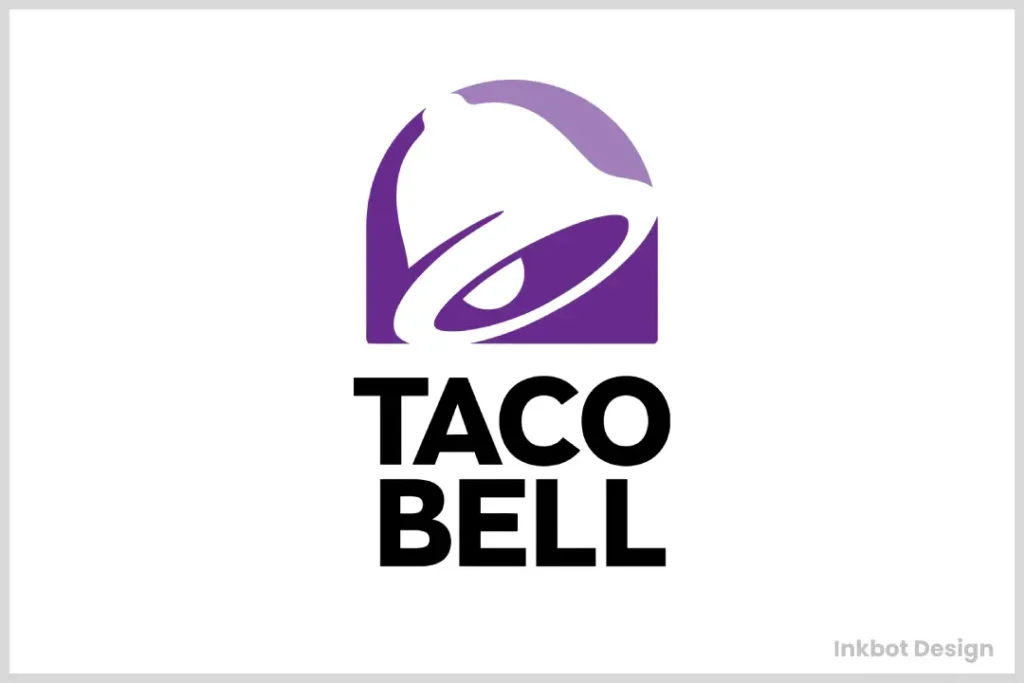
From hard shell to chalupa, Taco Bell slings affordable Mexican munchies from over 7,000 stores under a zingy logo that customers easily recognise for late-night cravings.
South of the Border on a Budget
The Taco Bell logo splashes a purple bell shape as the central image, underlined by the company name in bold letters. Everything angles slightly left as if set in motion. The bell's vibrant purple stands out while referencing food identity.
Core Identifiers:
- Bell imagery nodding to brand name
- Colour palette of vibrant purple and green
- Dynamic angling creates movement
Frills-free and budget-easy, this logo works ideal magic for value-driven eats where basic recognisability keeps service speedy for late-night drive-thru changes.
Run for the (Purple) Border!
Founded in 1962 in California, Taco Bell opportunistically captured emerging interest in Mexican flavours for American fusion fast food. Early logo design introduced colour and spice by encasing Taco Bell in red chilli pepper.
This evolved into 2008's current icon, swapping the pepper shape for a purple bell. The simplified zooming bell also increases brand alignment, improving functionality for digital spaces.
Through menu explosions introducing amped-up hybrid items like Doritos Shell tacos, Taco Bell leans aesthetics back toward basics. Focused visual identity keeps pace, taking customer cravings south of the border faster than ever.
#14 Burger King
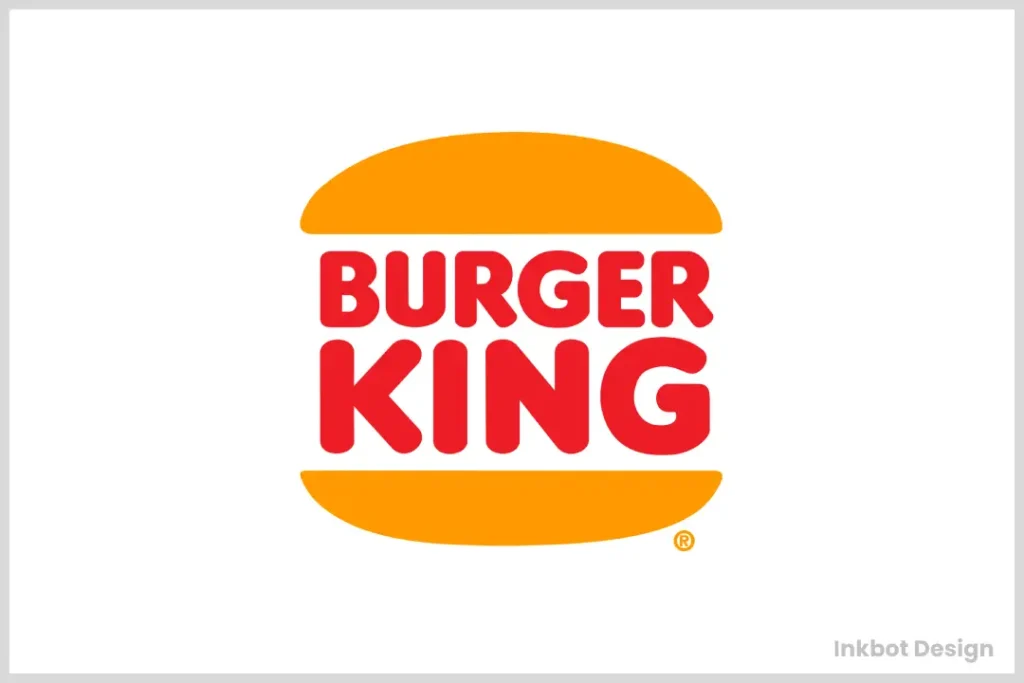
With over 18,500 flame-grilled storefronts spanning about 100 countries, chances are good a Burger King sign shines somewhere in sight. Its iconic blue, red and yellow logo sears burgers into worldwide fast food fame.
It'll Have You Screaming
The Burger King logo inserts “BURGER KING” in thick, bold red letters squeezed between two golden bun frames. The top bun arches across the red text, exposing yellow spikes akin to sesame seeds. The bottom bun similarly curves under the font in snug sandwich imagery.
This clever design figuratively conveys Burger King’s full-flavoured fare wrapped between tender buns. Stark white lettering resembles juicy patties sizzling with flavour.
Principal Logo Cues:
- Bun-framed lettering
- The red, yellow, and brown colour palette
- Sans serif font resembling patties
It's a brilliant integrated concept fusing text and image for a globally identifiable design seared into visual memory.
Flipping the Script
Burger King dates back to a small shop in 1953 in Florida before rapidly expanding nationally by 1967. Its logo evolution swapped through various names like Insta-Burger King before settling into the current iconic design in 1969.
For 50+ years, the signature “bun” look persevered despite fiercer burger competition heating up worldwide. Even contemporary simplifying merely smoothed lines adapting for digital spaces rather than overhauling their visual effectiveness.
The proof remains in the pudding (or burger) through logo longevity, cementing Burger King among the most instantly recognisable restaurant brands anywhere, thanks to the squeeze between those memorable buns.
#15 Chick-fil-A
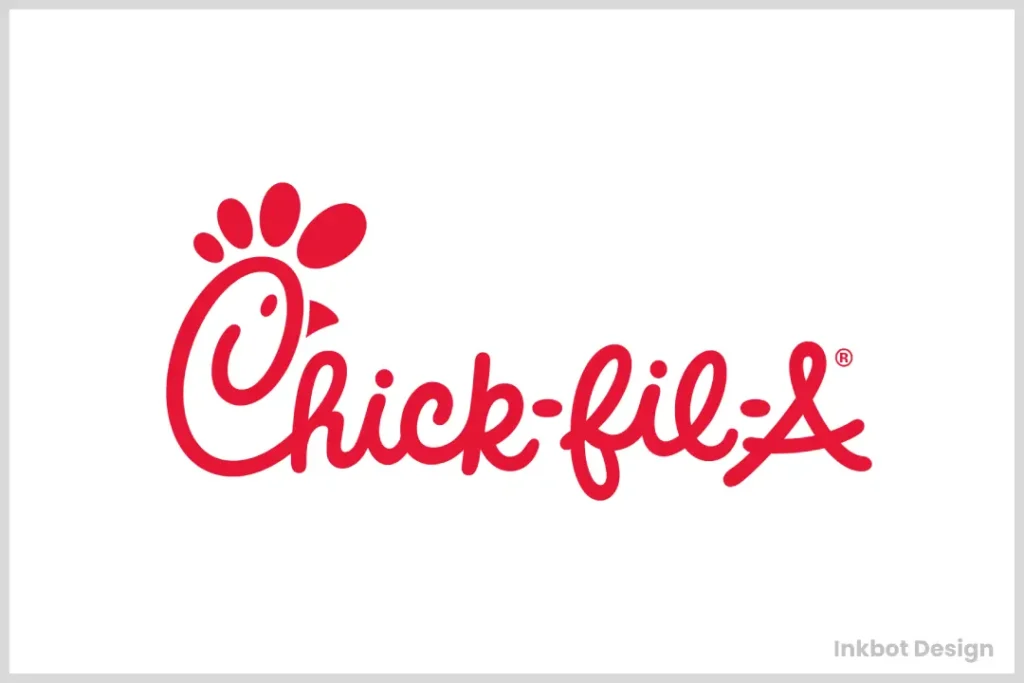
Closed on Sundays but open for excellent logo design, Chick-fil-A fries the competition through brand recognition, knitting a lovable mascot with God-fearing roots.
A Distinct Brand Story
The Chick-fil-A logo showcases a perky cartoon cow flexing a beefy bicep alongside two significant “CFA” letter marks. Underneath, the phrase “Eat Mor Chikin” is spelt out in lowercase red paint strokes, nodding to homespun cow signage.
It’s a quirky positioning for a chicken chain, using a mischievous cow mascot to capture charm. Font choices thoughtfully combine corporate authority with personable touches.
Defining Logo Features:
- Animated cow mascot
- Hand-brushed “Eat Mor Chikin” tagline
- A mix of uppercase sans serif letters and lowercase brush script
This warm, unexpected combo fuses heart and heritage for a distinct customer experience promoting worthy values.
A Legacy of Worker Care Goes a Long Way
Despite launching its first chicken sandwich store in 1967 Atlanta, Chick-fil-A lagged more considerable competition through the 20th century. However, stubborn focus on closed Sundays for rest, team investment, and quality ingredients steadily earned supporters.
Once echoing its cows to switch from “burger boredom”, Chick-fil-A saw sales leap into the industry’s top ranks through logo-touted principles prioritising people above profits to deliver consistent hospitality and flavours.
Conclusion
A logo is make-or-break for restaurants aiming to attract and retain customers. It is the face of the business, conveying brand personality and promise every time diners encounter it on signage, packaging or marketing.
The examples here showcase how big and small restaurants project their distinct identities through logos that encapsulate the essence of their offerings. From global giants like McDonald’s and Starbucks to chains like Chick-fil-A and Taco Bell, logos serve as signature visual mnemonics through colours, fonts, icons and mascots.
Whether emphasising quality ingredients, unique themes or founder personality, these 15 restaurant logos convey brand ethos memorably and appetisingly to turn heads and stomachs!
FAQs
Here are five frequently asked questions about famous restaurant logos:
Which restaurant has the most recognisable logo?
According to Brand Keys and other rating firms, McDonald's Golden Arches logo takes the prize for being the most recognisable restaurant logo globally. It beats out the second most recognisable logos, like Starbucks.
Why do branded restaurant logos matter?
Logos are visual shortcuts, triggering quick brand recognition and helping steer customers' purchasing choices. Memorable logos link positive attributes to drive sales.
Which companies frequently update logos?
Fast food chains update logos more frequently than dine-in counterparts, given that quick service models depend more on external advertising for purchases from passing traffic.
What makes an effective logo?
Compelling logos feature clean lines, thoughtful colour palettes aligned to brand identity, integrated text and visuals, and distinct yet versatile aesthetics for adaptation across contexts.
How can companies measure logo effectiveness?
Market research gauges logos success through quantifiable means like brand familiarity surveys, visual recognition tests, sales correlations and more. Companies also trace online clicks, social media shares, and customer query keywords related to logo changes.
